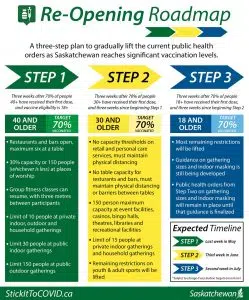Summer is right around the corner and — if the Saskatchewan government’s Re-Opening Roadmap goes to plan — it could come with few public health measures and a high percentage of adults vaccinated against COVID-19, bringing the province close to what it was before the pandemic.
During a media conference Tuesday, Premier Scott Moe said there were several reasons for unveiling the plan now.
“The No. 1 reason is this is the request that we are hearing as representatives across the province, myself and many other MLAs,” Moe said. “They’re hearing questions from the people they represent with respect to, ‘We’re continuing to follow the public health measures that are in place. Yes, we’re going out to get vaccinated. How does that find us back to some degree of normal in our communities?’
 “What this plan does is, one, it’s proven to work in other nations … Two, this is a plan that does have a finish line in sight and it does provide a very clear path on how we can achieve that finish line together in community after community across this province.”
“What this plan does is, one, it’s proven to work in other nations … Two, this is a plan that does have a finish line in sight and it does provide a very clear path on how we can achieve that finish line together in community after community across this province.”
Those measures include getting vaccinated and following public health measures.
The plan is to gradually ease public health orders in three steps as the percentage of adults who have received a first dose of a COVID-19 vaccine hits certain targets. Once the vaccination target is reached, three weeks must pass so these newly vaccinated adults have time to develop an immune response.
The key, Moe said, is the province’s vaccination rollout — and he was very blunt when addressing those who are still undecided about getting a shot.
“If you’re on the fence, this should really be one of the easiest decisions that you’ll ever make in your life,” Moe said. “On one side of that fence, people are living. On the other side of that fence, people are dying. It’s quite simple for all of us.”
TIMING OF THE THREE STEPS
Nothing with the current public health order changes as of Tuesday. It is to remain in effect until May 10.
However, the first step could start as soon as the last week of May. Some dates for when Saskatchewan could reach these targets were offered by the government, based on the current pace of vaccinations. However, those dates are stressed to be only estimates. It depends on uptake of the vaccine and the availability of doses to administer.
STEP ONE – LATE MAY
Step One may start as soon as the last week of May. It would begin three weeks after 70 per cent of residents age 40 and above have received their first dose, and once vaccine eligibility has opened to all adults ages 18 and older across the province.
The province currently is 65 per cent of the way toward that target.
During this step, the Regina area, which has been under more strict public health orders, would see its restrictions brought in line with what is in place for the rest of the province.
For all of Saskatchewan, what will be newly allowed in Step One is:
- A maximum of 10 people at indoor and outdoor gatherings, including household gatherings
- Public indoor gatherings of a maximum of 30 people
- Public outdoor gatherings of a maximum of 150 people
- Restaurants and bars — Six people can sit at a table. A two-meter distance or a structural barrier would need to be in place between tables. VLTs can be made available.
- Places of worship – They can allow up to 150 people, if they have the space. Otherwise, they can allow up to 30 per cent capacity with distancing between households.
- Group fitness classes that involve intense training, such as aerobics – These classes have to maintain at least three metres between participants.
What restrictions and protocols won’t change in Step One:
- Retail, personal care services, event facilities, casinos, bingo halls, theatres, art galleries, libraries and recreational facilities must continue with current restrictions.
- Primary, secondary and post-secondary education and childcare facilities must continue with current protocols.
- Dance floors and buffets are not allowed.
- Mask-wearing continues.
STEP TWO – LATE JUNE
Step Two could possibly start by the third week in June. It will begin after 70 per cent of residents age 30 and above have received their first dose, with at least three weeks passing since Step One started.
So far, 53 per cent of residents 30 and over in the province have got their first doses.
For all of Saskatchewan, what will be newly allowed in Step Two is:
- A maximum of 15 people at private indoor gatherings, including household gatherings
- A maximum of 150 people at private outdoor gatherings.
- Retail and personal care services will have no capacity thresholds, but they must maintain an occupancy that allows for physical distancing.
- Restaurants and bars — no table capacity thresholds, but they must maintain two metres of physical distancing or structural barriers between tables.
- Event facilities, casinos, bingo halls, theatres, art galleries, libraries and recreational facilities – can have 150 people maximum. Physical distancing must be maintained and will determine the occupancy of the building. Those venues that serve food must follow restaurant guidelines.
- Youth and adult sports will have all restrictions lifted.
What restrictions and protocols won’t change in Step Two:
- Primary, secondary and post-secondary education and childcare facilities must continue with current protocols.
- Gyms and fitness facilities must continue with current protocols.
- Dance floors and buffets are not allowed.
- Public outdoor gatherings remain at a maximum of 150 people.
- Mask-wearing continues.
STEP THREE – MID-JULY
Step three – the final step – could possibly start as early as the second week in July. It will begin three weeks after 70 per cent of residents age 18 and older have received their first dose, with at least three weeks passing since Step Two started.
As of Tuesday, 44 per cent of those 18 and over in the province have got their first doses.
During this final step, most remaining restrictions will be lifted. Gathering sizes and indoor masking guidance at that time will be based on “the progress of the first two steps.” Until that guidance comes out, public health orders on gathering sizes and indoor masking from Step Two will continue.
Moe said the province expects to receive 367,000 doses of vaccine in May and Dr. Saqib Shahab — Saskatchewan’s chief medical health officer — called May and June “blockbuster months” for vaccine supply.
Both men reiterated that mass immunization is necessary for the plan — and that includes second doses, which will begin immediately after all residents have access to a first dose.
“While we have a 70 per cent vaccination threshold for the reopening plan, it remains our goal to achieve a much higher immunization rate,” Shahab said. “We need to seek inspiration from our seniors and elders who have well over 85 per cent vaccination rate.”
Moe said he expected to hear some people say the plan is moving too fast, but he pointed to other countries like the United Kingdom that started to reopen with fewer people vaccinated.
The premier also had a message for those who think Saskatchewan’s plan is moving too slowly, saying there’s still a need for caution.
“While our case numbers and our hospitalizations have been stable or even declining slightly over the course of the last few weeks — both down about 20 per cent from their peak in April — we do need to wait just a few more weeks so that more people are able access their vaccine before we start lifting current restrictions,” Moe said.
NDP responds
In a statement, NDP Health Critic Vicki Mowat said it was good to hear the government provide some clarity for its plans Tuesday, but she noted the NDP has been pushing the government to provide benchmarks since last March.
“We believe that Saskatchewan families deserve to see the modelling and public health advice that has led to this decision,” Mowat said.
“It’s concerning that it appears the only metric being used is vaccination numbers. Vaccination numbers are important, but they do not tell the whole story. With Alberta imposing further restrictions today, we need to keep a close eye on case counts, test positivity, hospitalizations and other public health indicators to guide our steps forward.”











